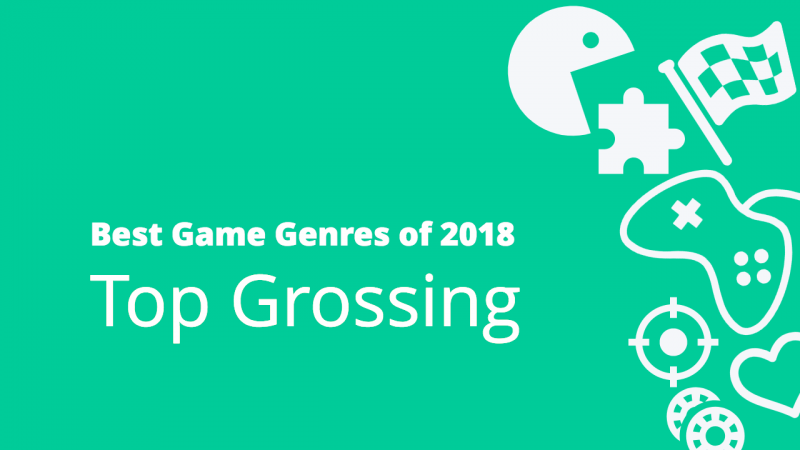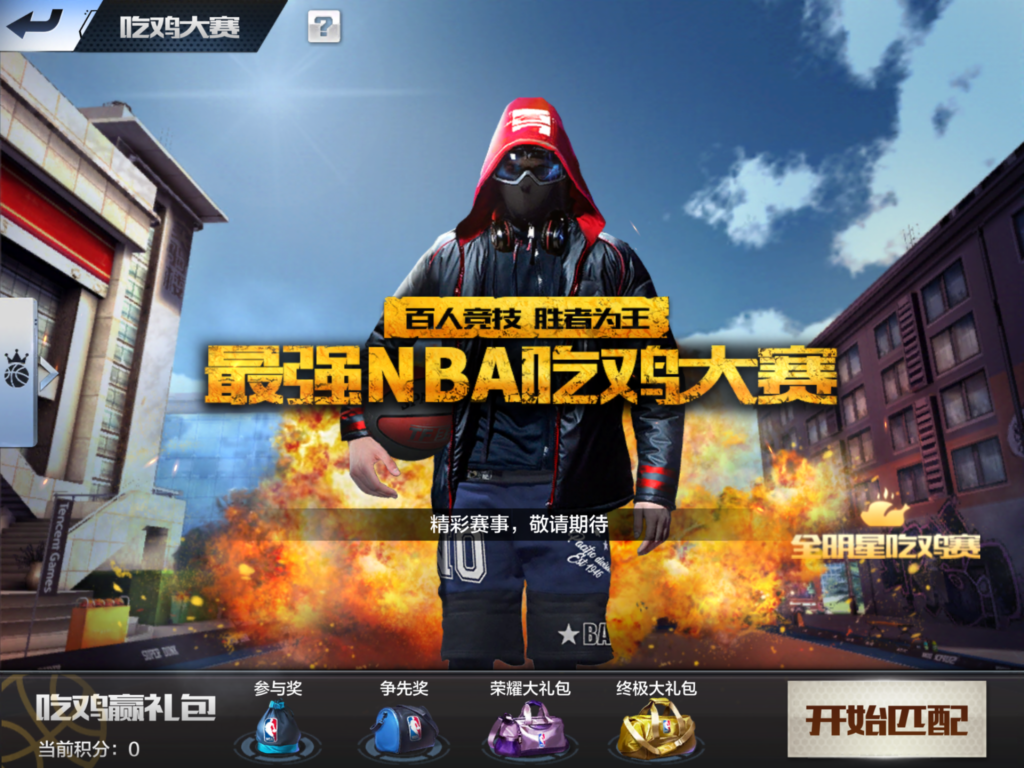Using data from GameAnalytics’ latest industry report, GameAnalytics reveals the key lessons in keeping your games’ retention and engagement healthy.
Editors note: this post was originally published by Ana Laura Serra, Head of Data Science at GameAnalytics. With extensive experience in applying mathematical models to real phenomena, she’s an expert at finding key insights from large amounts of data.
One of the best ways to find out how your title is performing is by taking a long hard look at the retention and engagement of your game. Not only are these great ways for you to measure the playability of your title, but these metrics give developers an early sense of if their game is going to succeed or not.
Hugo Peyron, Publishing Expert at Voodoo, even commented on the importance of retention – especially when they take on new games: “We look for the highest numbers possible. If a game has low retention, we will kill it.”
With this thought in the back of our heads, the biggest question developers tend to find themselves asking is: “How can I boost my retention and increase the engagement of my game?” And by looking at key stats from GameAnalytics’ 2018 Industry Benchmarks Report, they answer just that…
Stats at a glance:
There’s a bunch of stats and figures in GameAnalytics’ report and this blog. If you’re short for time and just want the goods, they’ve rounded up all of the top retention stats here:
- On average, the top performing titles have retention of:
- 40% for Day 1
- 15% for Day 7
- 6.5% for Day 28
- The genre with the highest retention is Word, with D28 retention as high as 15%.
- The genre with the lowest retention is Kids, with D28 retention as high as 1.8%.
- On average, people are playing the top performing titles for around 15 minutes per session.
- Card and Casino are leading this, with people playing these genres for up to 35 minutes per session.
- For most genres, having less than 7% stickiness is considered bad.
- And the top performing games have an average of 20% for their titles Stickiness.
How to read our graphs
Some of the data presented in this blog comes from GameAnalytics’ 2018 Industry Benchmarks Report. To help you understand how to read these, they’ve collected their findings and presented the data for each metric in two separate ways:
1. Overall Yearly View
Aggregated genre data broken down into top, median and underperforming titles (green, yellow and red lines) to show industry trends over the last year.
2. Genre Specific Breakdown
Data that looks specifically at how each genre is performing and highlights the top, median and underperforming KPIs (star, grey line and red arrow).
Now that you’re familiar with our graphs, let’s dig in to our top lessons from our report…
1. Perfect your core loops
Players can lose interest in repetitive things easily, which is a good reason why your retention may be suffering. If we look at day 7 retention for most genres, we can see that the top games are performing between 15% and 30%. If your game is seeing day 7 retention around here, then you’re doing pretty well when compared to the industry.


If you’re below 15%…
However, If you find that your game is underperforming, not all is lost. To keep players interested (especially when thinking about your core loops), you’ll want to make sure players can unlock new content, be that: items, areas or levels. Don’t let them get bored!
There’s a ton of advice on how to perfect your core loop. To save us from rambling on though, take a look at our other post that covers pretty much everything you need to know when it comes to core loops: How to perfect your games core loop.
Use Funnels to find out when your players drop off
For those who are unaware of funnels in analytics, using the funnel capability lets you know how your players progress through your game, and more specifically, at what stage they leave.
Focus your efforts here, identify when people drop off, and experiment with different fixes. Choose the best performing route and go with that.
2. Perfect your endgame
If players are sticking around until day 28, then they pretty much love your game. In GameAnalytics’ 2018 Industry Benchmarks Report, the best performing games show around 6% D28 retention, whereas the bottom performing are at 0% (ouch).
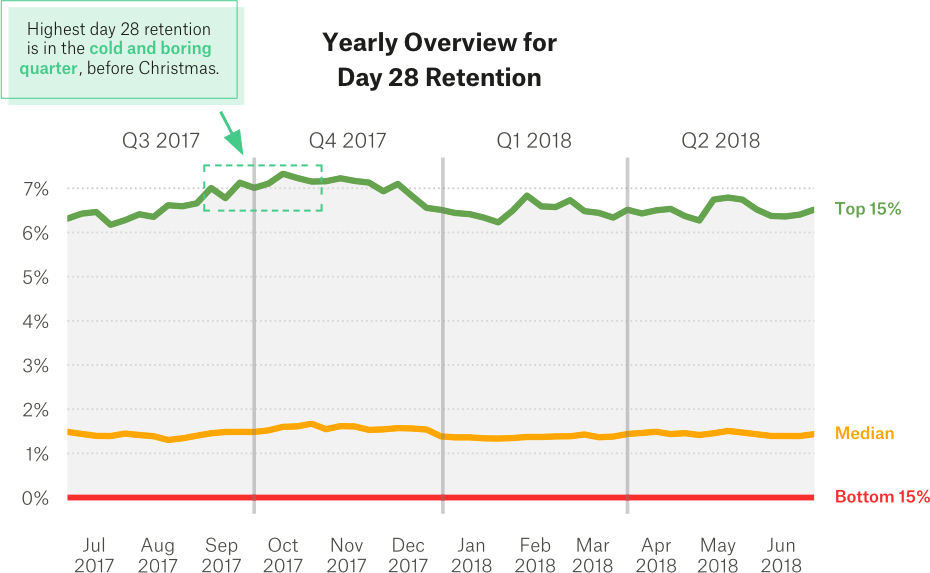
Most games tend to run out of steam at this point, however fixing this stage tends to be easier than fixing day 7 retention, as these players are already engaged. And although designing an open ended game can be quite tricky, it’s not impossible.
There are plenty of ways to keep your players entertained at the end of your game, your imagination is your only limitation. But, to give you some inspiration, you could try:
- Letting players battle against each other in PVP modes.
- Adding new challenges each day (most of which don’t need to be overly complex, just something to keep them interested).
- Introducing leaderboards, so to appeal to their competitive side.
3. Keep them loyal
Sadly, your players will never truly be loyal only to your game. Your title realistically will be battling for their attention against films, books, other games, social media, TV shows and more. Much more.
This being said, people are creatures of habit. What you really want to do is fit your game into one of their many habits – whether that be their 3 minute coffee queue in Starbucks, their 5 minute wait for the 94 bus into Oxford Street, or those 2 crucial minutes while the microwave blasts their midnight Super Noodle snack.
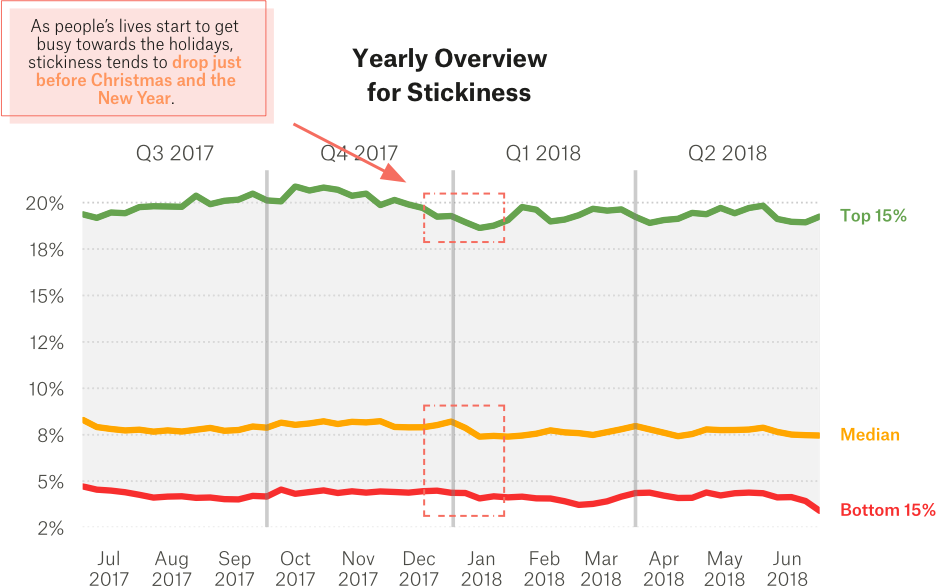

GameAnalytics’ findings show that Stickiness tends to drop just before the Christmas period (as people’s lives tend to get busier when the Holidays approach). The highest point for Stickiness is at the beginning of Q4 (around October time). If you’re hoping to make your game a key part of your players lives, this would be the perfect time to ramp up advertising, but also increase promotions, giveaways and freebies.
GameAnalytics actually talks a lot about building habits for your players in one of their other posts. You can check it out here: Why Habit Formation Is The Key To Long Term Retention.
4. And reward those loyal players
Users ultimately control how long they play for, so it’s important to not limit their gameplay. If they complete 10 levels within a game and end up playing for 20 minutes or more, these players should be rewarded to make sure they have a good experience. And this rule should realistically apply to any retention stage, whether that be day 1, day 7 or day 28.
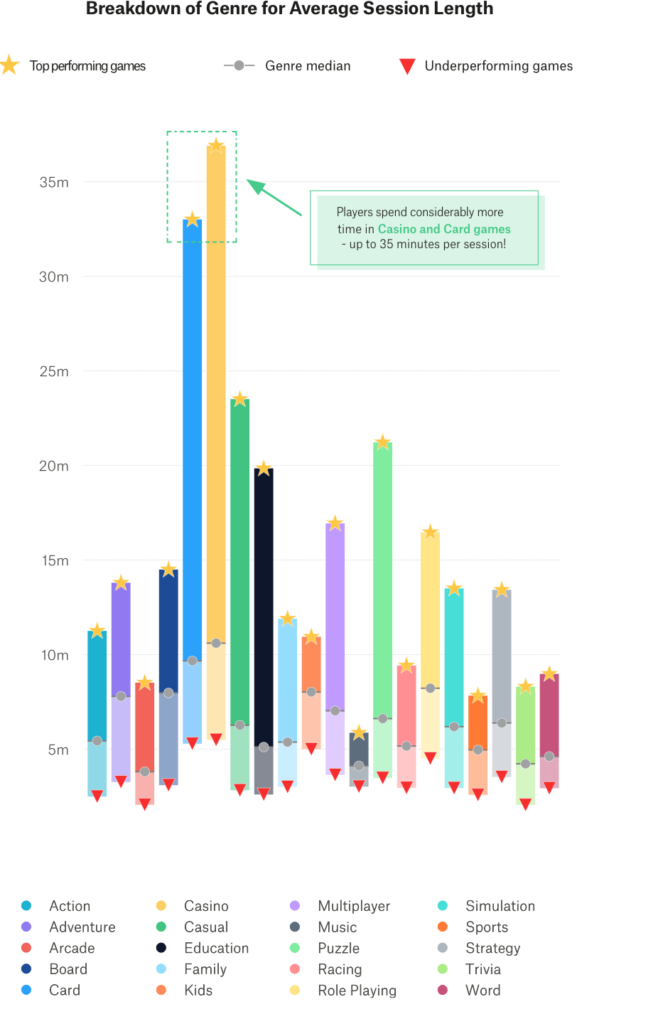

If you’re going to use this tactic, it’s important for you to know what the average session length is for the industry and more specifically, your genre. Our data shows that Casino and Card games are high, whereas other genres have around 5min-10min Average Session Length.
Although you should use this graph as a benchmark to know when to reward your most loyal players, remember to also look at your own data. That way, you can avoid rewarding your players too early, or too late.
Ways to reward your loyal players:
- Give them free stuff
- This can be with coins, items, or lives.
- Give them achievements
- If they’ve played for longer than 20 minutes, give them a medal, and entice them with other achievements as well.
- Give them discounts
- You can give them discounts to a subscription to your game.
- Or, discount codes to other games you’ve created.
5. Lastly, know when to cut your losses
Day 1 retention is arguably the most important metric when it comes to measuring the health of your game. If your retention starts off low, chances are you’re going to either need a complete overhaul of your game, or simply kill your darlings and move onto the next project.
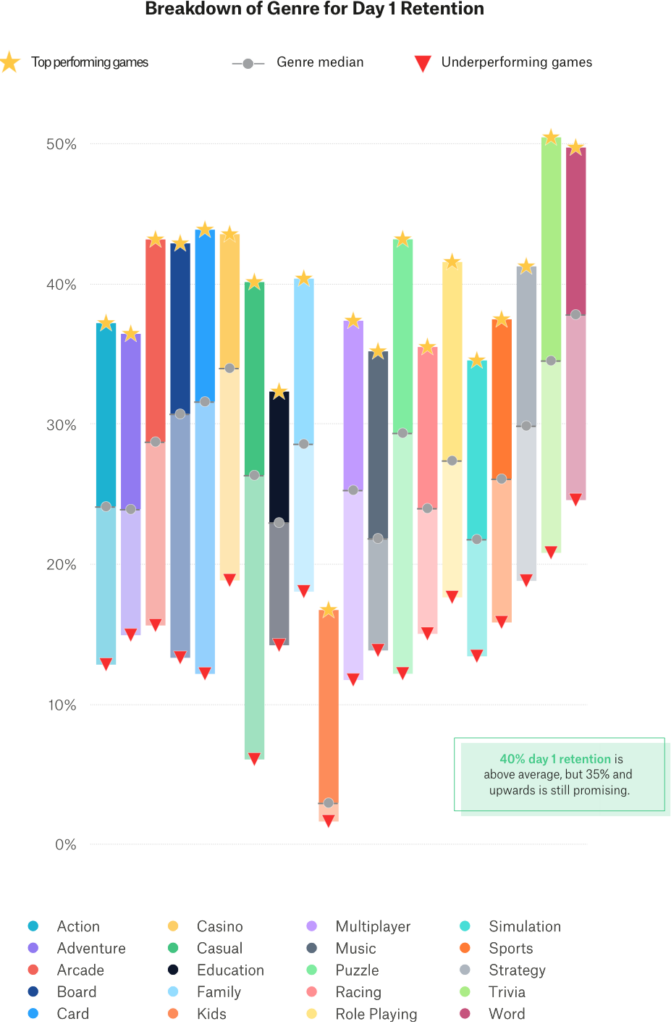
Knowing when to do so is just as important as all of the other tips we’ve given you throughout this post. Most publishers look for around 40% D1 retention, so if you’re performing above at least 35%, then your game is doing really well compared to the industry.
However, make sure to take the genre of your game into consideration. The best performing titles for Trivia have around 50% D1 retention, whereas the Kids genre have an extremely low retention rate, with the best performing titles achieving only 16% D1 retention.
Other great tips and tricks
If you enjoyed reading this post, then we recommend checking out these quick reads from GameAnalytics:
- 3 Creative Ways To Build Your Community Before Launching Your Game.
- 6 Ad Creative Strategies To Nail Your User Acquisition.
- How To Do An Efficient Game Test.
- How To Make Your Game UI Shine & Increase Conversions.
- Mobile vs Desktop UI: Key Differences In Design.
Also, make sure to download a copy of GameAnalytics’ 2018 Industry Benchmarks Report. There’s a ton more useful tips and tricks in there, as well as top stats from other key metrics.


